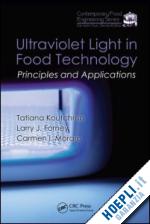
Questo prodotto usufruisce delle SPEDIZIONI GRATIS
selezionando l'opzione Corriere Veloce in fase di ordine.
Pagabile anche con Carta della cultura giovani e del merito, 18App Bonus Cultura e Carta del Docente
The production of environmentally friendly, sustainable, chemical-free food continues to challenge the food industry, spurring on investigations into alternative food processing techniques that are more sophisticated and diverse than current practices. Exploring one of these emerging solutions, Ultraviolet Light in Food Technology: Principles and Applications incorporates the fundamentals of continuous and pulsed UV light generation and propagation; current food regulations; recommendations for optimal UV reactor design, selection, and validation; information on both commercially available and under-development UV sources; and the outlook for future food applications.
After reviewing essential terms, definitions, and current applications, the book emphasizes the need to properly assess the physical and chemical properties in foods that influence the effectiveness of UV treatment and impact inactivation kinetics. It also addresses the effects of UV processing on food quality, before considering the engineering aspects of UV light treatment, such as transport phenomena, process calculations, and continuous-flow reactor geometries. The book then describes the principles of validating UV reactors as well as the principles and applications of UV pulsed light, including microbial inactivation in water, meat, fruits, vegetables, and packaging materials.
For anyone working in food research, development, and operations, this resource provides broad, accessible information on the science and applications of UV light technology. It shows how UV light irradiation can be used as a physical preservation method in food processing.
Principles and Applications of UV Technology
Basic Principles of UV Light Technology
Propagation of UV Light
Application Guidance in Food Processing
Current Status of US and International Regulations
Sources of UV Light
Introduction
Mercury-Emission Lamps
Amalgam UV Lamps
Special Lamp Technologies
Guidelines for Choice of Lamp Technology
Characterization of Foods in Relation to UV Treatment
Terms and Definitions
Analytical Measurements
Absorptive and Physicochemical Properties of Liquid Foods
Food Solids and Surfaces
Conclusions
Microbial Inactivation by UV Light
Mechanisms of Microbial Inactivation by UV Light
UV Sensitivity of Pathogenic and Spoilage Food-Borne Microorganisms
UV Sensitivity of Waterborne Pathogens
UV Sensitivity of Food-Borne Pathogens
UV Inactivation Kinetics and Competitive Effects in Foods: Absorbance, pH, Solids, and Other Components
Methods to Measure, Quantify, and Mathematically Model UV
Inactivation
Efficacy of Low-Pressure, High-Intensity Lamp for Inactivation of Food Pathogen
Conclusions
UV Processing Effects on Quality of Foods
Basic Considerations
Chemistry of the Photodegradation of Organic Compounds
Shelf Life and Quality Changes in Fresh Juices
Effects of UV Light on Degradation of Essential Vitamins
Effect of UV Processing on Milk Quality
Shelf Life and Quality Changes in Fresh Produce
Degradation and Formation of Chemical Compounds in Foods
Conclusions
Transport Phenomena in UV Processing
UV Irradiance in Liquid Foods
General Hydraulic Condition
UV Process Calculations for Food Applications
Establishment of Specifications for Preservation
Delivery of the Scheduled Process
Measurement of UV Dose Delivery
Conclusions
Reactor Designs for the UV Treatment of Liquid Foods
Laminar Flow in Concentric Cylinders
Turbulent Flow in Concentric Cylinders
Taylor–Couette Flow in Concentric Cylinders
Comparison of Disinfection in Concentric Cylinders
Turbulent Channel Flow
Dean Flow Reactor
Evaluation of UV Reactor Design
UDF Source C Codes
Principles of Validation of UV Light Pasteurization
Validation Concept
Validation at Different Phases of Process Development—Scale-Up
Process
Key Components of Validation Procedures
Conclusions
Pulsed-Light Treatment: Principles and Applications
Description of Pulsed-Light Treatment
Inactivation of Microorganisms by Pulsed-Light Treatment
Applications of Pulsed-Light Treatment
Future Prospects of Pulsed-Light Treatment in the Food Industry
References appear at the end of each chapter.











Il sito utilizza cookie ed altri strumenti di tracciamento che raccolgono informazioni dal dispositivo dell’utente. Oltre ai cookie tecnici ed analitici aggregati, strettamente necessari per il funzionamento di questo sito web, previo consenso dell’utente possono essere installati cookie di profilazione e marketing e cookie dei social media. Cliccando su “Accetto tutti i cookie” saranno attivate tutte le categorie di cookie. Per accettare solo deterninate categorie di cookie, cliccare invece su “Impostazioni cookie”. Chiudendo il banner o continuando a navigare saranno installati solo cookie tecnici. Per maggiori dettagli, consultare la Cookie Policy.